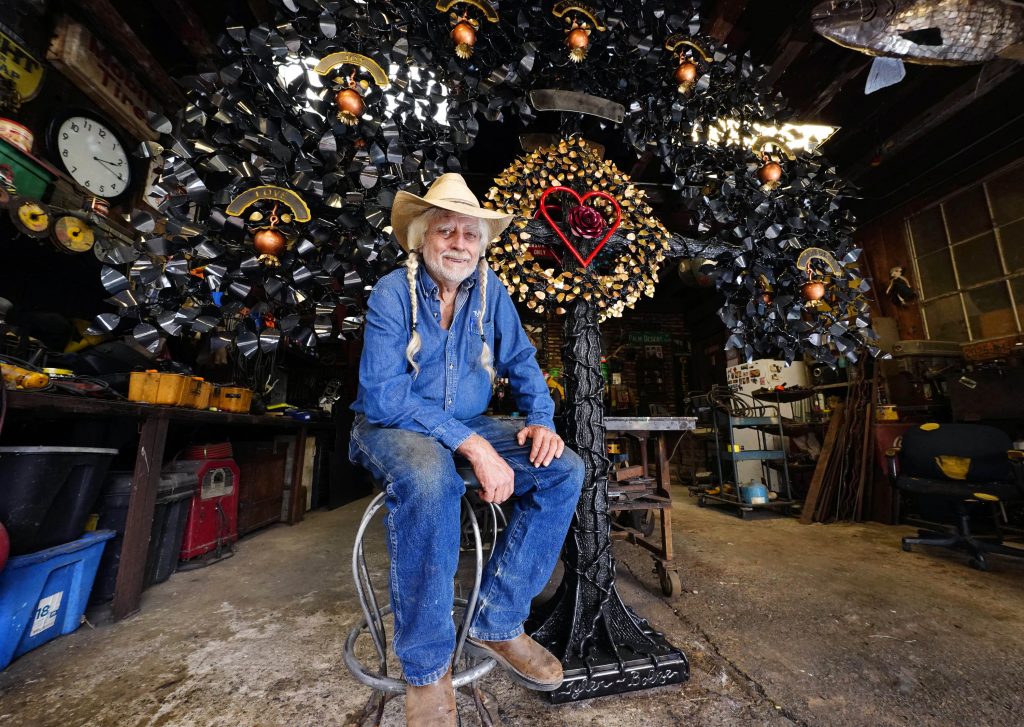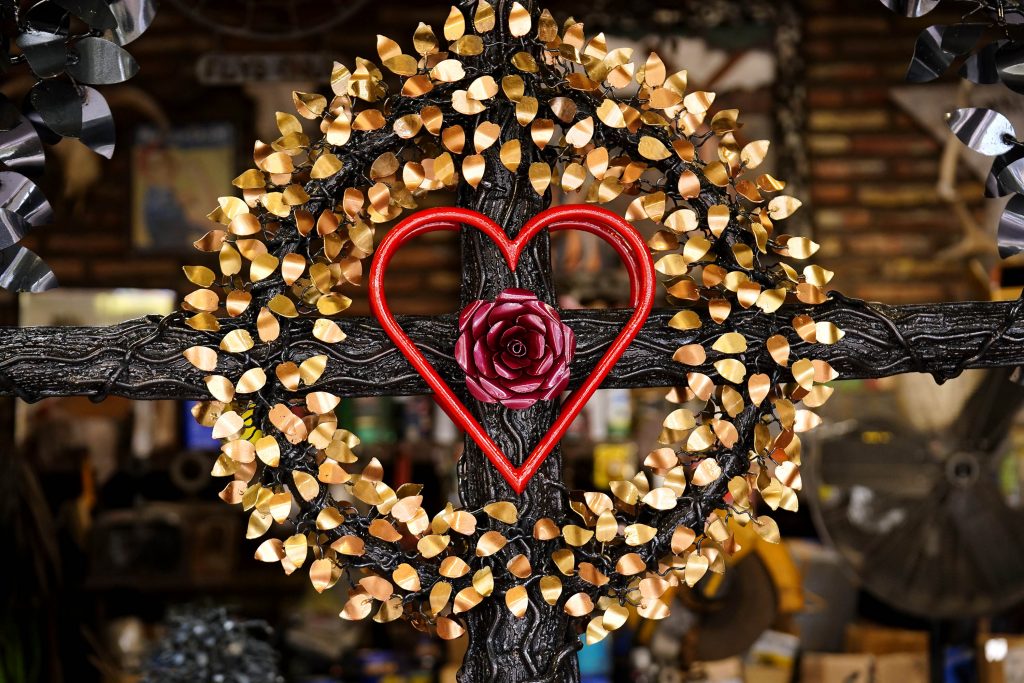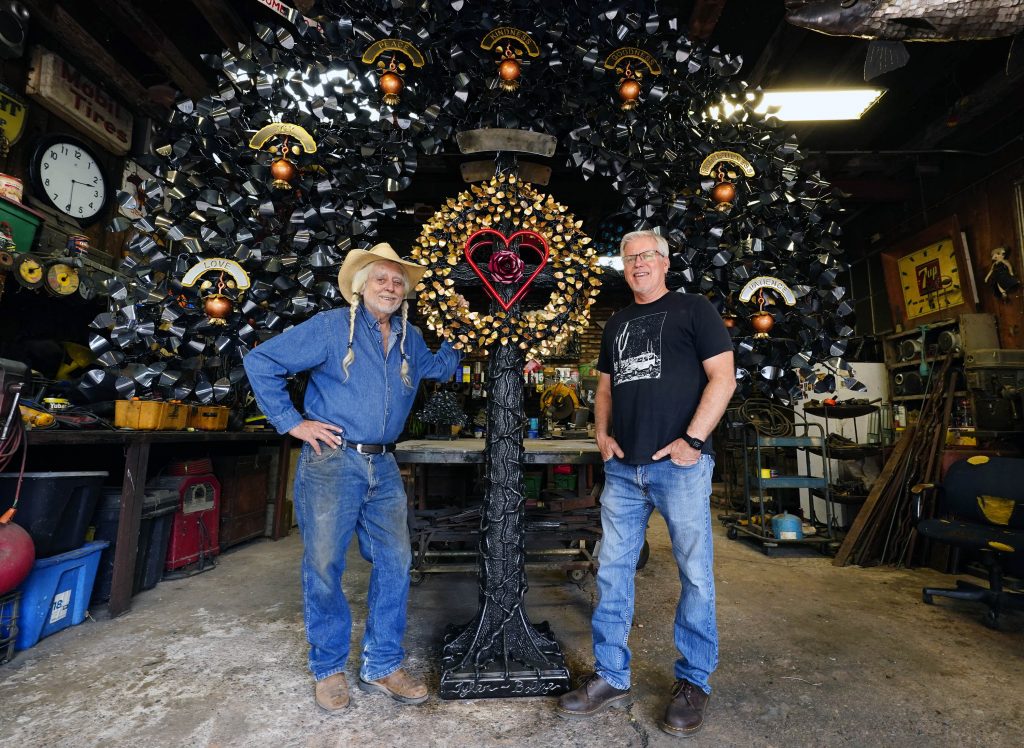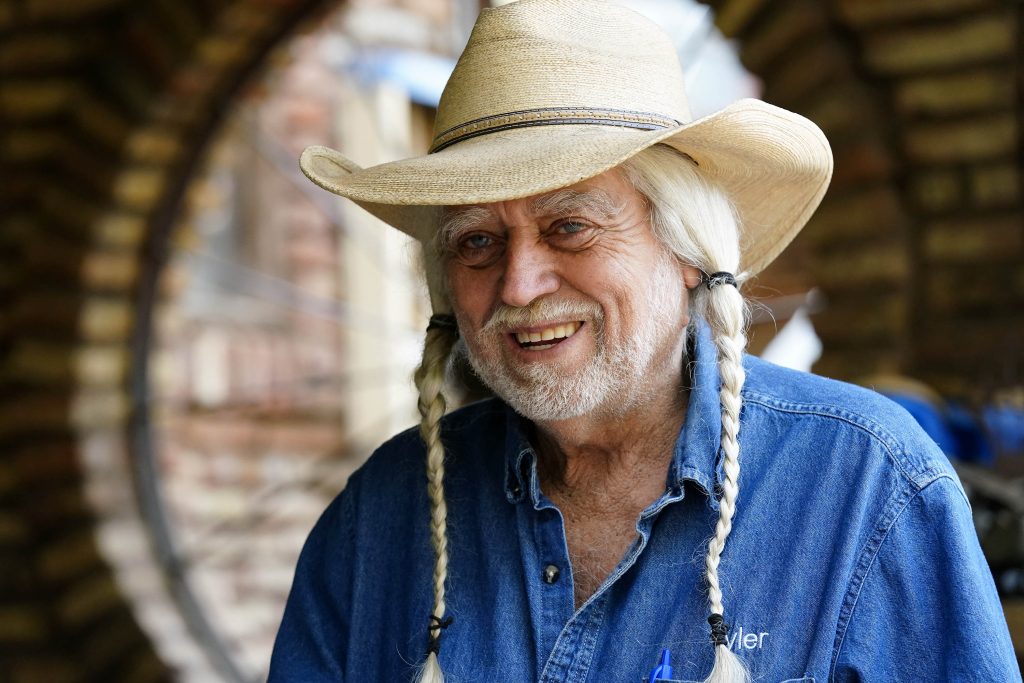
Photos by Ralph Freso / Slideshow
SURPRISE, Ariz. — Far from the urban sprawl of Grand Canyon University …
At the dead end of a mean dirt road …
Past the towering, Gothic-esque iron gates …
Under a canopy of Medjool date palms, Canary Island pines and Rockford pines huddled together to block the hostile Arizona sun …
Joe Tyler found grace.
He danced in the light of it in this magical place, once part of the sprawling Padelford Ranch. It’s where the horticulturist-turned-botanical artist nurtured many of the 500 varieties of towering, majestic trees on the property from seedlings and turned a onetime cotton gin into his funky, 40-acre artist’s oasis.
This place in rural Surprise, at the dead end of a mean dirt road, is offbeat and fascinating and unlike any property you’ll ever see.
Rabbits and roadrunners sprint across the driveway, and full-of-attitude bobcats on occasion plop down in his sculpture workshop as if they owned the place.
It’s a beautiful assault on the senses, there’s so much to see.

There’s the mailbox, entwined in metal vines, a sculpture of a horny toad, the grotto where his men’s Bible group meets and where he played blues concerts back in the day, and a sculpture of a lizard on a swing on the roof of his shed-meets-welding-shop.
But here is where Tyler, in the midst of the pandemic, sculpted a metal tree for himself, a red heart in the middle, “to stay sane during COVID,” he said.
But he had a vision of something bigger.
That first piece would become the inspiration for the "Grace Tree,” which he donated to GCU. The work was unveiled on campus on Monday in commemoration of its 75th anniversary.
The 15½ -foot-tall, 11-foot wide metal sculpture, adorned by 2,000 shiny black leaves contrasting the copper pomegranates hanging from its branches, sits between the Lope Shop and Prescott Field.
At the center of the tree, whose trunk and branches form a cross: a red heart, a rose that represents the Rose of Sharon and, to Tyler, the word that says everything: “Grace.”
“That’s my favorite word,” said the 73-year-old sculptor, his distinctively long silver braids sitting Willie Nelson-like below his cowboy hat. “It says it all. If you read the fruit of the Spirit, that’s how we’re saved.”
Each pomegranate on the tree represents the fruits of the Spirit, taken from Paul’s writing in Galatians 5:22-23:

“Patience”
“Faithfulness”
“Goodness”
“Kindness”
“Peace”
“Joy”
“Love”
With its strong Christian themes, the "Grace Tree” is finding a fitting home at Christian university GCU.
“There’s a lot of symbolism in there. But grace," he said, “is what Christ is all about.”
Horticulture to sculpture
Tyler never set out to be an artist.
The native Phoenician wanted to attend GCU, but it didn’t offer a horticulture program when he started college in the 1960s. So he made his way to Arizona State University, where he graduated with a master’s degree in environmental horticulture.
Cultivating plants and gardens was his life.
He owned his own tree farm and nursery for 15 years and moved to the property that’s now his home because it was close to his business – and to escape the growth of Phoenix (though the suburbs are now just a few miles away).
Smooshed up against a hill in the rural scrabble outside Surprise, he would whittle, mold, shape, bend and sculpt the land into his family’s home.
After he started landscaping, he wanted to place sculptures around his property.
“I couldn’t find anything that grabbed me. So when I was building the house, I taught myself to weld,” he said. “I thought, well, maybe I’ll just make a piece or two, play around with this a little bit.”
Once he got started, “He just couldn’t turn it off. He just kept going and going,” said his friend, Eric Bolze, director of engineering and production for E2 Innovations, a custom manufacturing and fabrication company that cut the 2,000 leaves for the "Grace Tree.”

Horticulture was his love; sculpting would become his passion.
The property itself is a giant piece of art.
A metal cutout of a bigger-than-life-sized white dove hangs above the thick wooden doors that lead into his home, where the ribs of Saguaro cacti wrap around the columns that divide the living area. A taxidermied bison head given to Tyler oversees the whole space, rich with its red throw rug, red velvet furniture and stand-up piano.
To the right of the doorway, a bar.
“It’s contoured from the cattle,” he said of the smooth indents at the edge of the bar top, once fence posting at the old Lizard Acres Cattle Feedlot, that’s carved with the names of friends who have dropped by his place over the years.
Tyler, in addition to his horticulture days and work as an artist, also was a blues singer; he sings a few bars now and again as he tours you around his home.
In his old bluegrass days, oh, the parties.
Vintage metal and wood cathedral radios and 1950s metal toys sit atop a shelf above the bar.
“They’re toys I had when I was a kid,” said Tyler, as is a lot of the red velvet furniture.
The sculptor likes his home to feel “lived in,” he said.
Finding a home at GCU
Tyler never intended to sell his sculptures.
“Then one day, somebody came out and said, ‘Oh, I’d like to buy that.’ And I go, ‘What?’”
After selling his nursery, where Sun City Grand now is, and tree farm, which was near the Wildlife World Zoo, he worked as the founding director of the Arboretum at ASU but continued creating sculptures at home.

“Doors started opening, and I just was a good listener to God,” said Tyler, whose first art show was in 1989. “… Pretty soon I found myself doing art full time.”
Not that his previous work ever left him.
“I’m still in love with horticulture and consider myself a horticulturist. That’s why my artwork is so heavily influenced by botanicals,” said Tyler, who’s known for his largescale public artworks at fire stations, libraries, malls, transit stops, downtown spaces and the like in Arizona, California, Texas, New Mexico, Nevada, Germany and Japan.
Among them: “The Learning Tree” outside the Surprise Regional Library; five welded steel trees called “For Every Drop of Blood” at the Glendale Public Library; the “Populous Freemonti-Tree” on Tempe Town Lake; the “Centennial Plant” in downtown Tucson, Arizona; and “The Reading Tree” in Windrose Park in Peoria, to name a few.
It was through Bolze that the artwork found a home at the University.
Bolze met Dr. Tim Griffin, vice president of Student Affairs, dean of students and University pastor, on a campus visit when his daughter, Alexis, was considering attending GCU. She wanted to major in worship arts, which wasn't offered at the time, but as fate would have it, the Worship Arts Program would be launched the next year.
“The whole family started to cry,” said Griffin.
Alexis graduated from GCU and worked on campus for a time as an event coordinator.

About a year ago, Eric Bolze contacted Griffin. “He said, ‘I know this famous artist by the name of Joe Tyler. He wants to donate a piece of art. Do you think GCU would be interested?’”
After a couple of field trips to view the piece, GCU’s leaders told him they would.
Tyler’s “Grace Tree” is the third sculpture to be installed on the campus in the past four years.
“This is the beginning of a lot of art being installed on campus,” Griffin said.
A sculpture of sports entrepreneur Jerry Colangelo, created by Gary Tillery and Omri Amrany of Rotblatt-Amrany, was placed near Global Credit Union Arena in 2019. And students created the trio of crosses, also near the Arena, that was installed in 2020 as a senior project.
Bolze, who makes the trek to Tyler’s place for men’s Bible study when he can, said of the sculpture, “Every aspect of it is great. … It’s part of his heart,” he said.
Griffin added how the work speaks greatly to GCU’s identity as a Christian university. It will be a place, he said, of meditation for the campus community.
A place to think about God’s grace.
“It will give students, staff, faculty and guests who come to campus a visual sense of what GCU is all about. It will be a wonderful place where our students and visitors can reflect on life and the mission of GCU, our Christian history and Christian commitment as an institution and how it can be reflected in a piece of art.”
Manager of Internal Communications Lana Sweeten-Shults can be reached at [email protected] or at 602-639-7901.
Related content:















